Jumping worm
PestTalks reader Carol, of Kenosha, Wisconsin, sent an email to Bossman Beytes with an inquiry about the management of jumping worm. She found some jumping worms in plants her mother purchased. Now, Carol is someone who knows her pests—she has worked for extension services in both Illinois and Wisconsin, and also as a nursery inspector for Wisconsin Department of Agriculture, Trade, and Consumer Protection. After her research on effective management methods came up empty-handed, Carol reached out to Bossman Beytes, who thought enough of me to loop me in.
You may be asking, "What in the world is a jumping worm?" It’s an invasive earthworm. Y’all might be shocked (hopefully not about people seeking my advice) and be thinking, “Earthworms are pests?!” Well, it depends. (Don't you just hate that answer?) Most of the time, the earthworms we know are beneficial—breaking down organic matter, recycling nutrients, building up soil, dangling as fish bait, etc. Just like everything else, they’re considered pests when they do what we don't want them to do at the wrong place and time. In my other role as a turfgrass entomologist, I work with golf course superintendents with their worm casting (i.e. earthworm poop) problems. You’d be mad too if your golf ball bounced off a pile of worm poop, especially when your reputation as the greatest golfer since Jack Nicklaus (or a couple of beers) is on the line. Most of the time, the culprits of worm casting problems are the common kinds—European earthworm, nightcrawler and the green stinkworm (Amynthas hupeiensis) at some locations.
I honestly knew nothing about the jumping worm. There are several Amynthas species in the United States. They are difficult to distinguish among species, so they are often referred to collectively as the jumping worm. All of them are invasive and have the same vigorous behaviors that give them other common names such as the Asian jumping worm, crazy worm, crazy snakeworm, snake worm, Jersey wiggler, Alabama jumper and Georgia jumper. I dug around a little and didn't find much information. I asked for help from my brain trust on the Onaent list serve, and Dan Potter (University of Kentucky), Dan Gilrein (Cornell University) and Gail Ruhl (Purdue University) shared their information. Carol also graciously shared the information she had gathered.
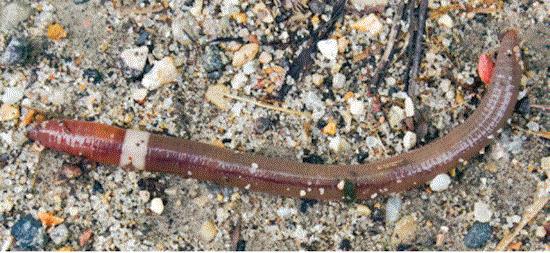
A jumping worm when it's not jumping. (Photo credit: Susan Day, University of Wisconsin Arboretum)
Despite common names that suggest southern origin, the jumping worm is native to East Asia (most likely Japan and Korea). It’s widespread in New England, and seen westward to Minnesota (found in Iowa in July 2018), and southward to Florida and Texas. The range will continue to expand. The spread in the United States is aided by its use as fish bait (which anglers often dump out at the end of the day), and potentially by movement of mulches (suggested by Josef Görres of the University of Vermont) and potted plants (witnessed by Carol). Historical records from the 1970s indicate its presence in a county next to mine, but I’ve never thought of looking for it. I will now.
The jumping worm is not difficult to identify. It moves like a snake, usually on the soil surface or just a little bit under the surface. It wiggles like mad when touched, making it extremely difficult to catch and giving it many wiggling and jumping common names. Its body is gray or brown, smooth, glossy and not coated with slime. Its clitellum (i.e. a band near the “head”) is smooth and milky white. The nightcrawlers are pinkish, slimy and have pink or reddish clitella. See videos of a wiggling mass and how jumping worm can change forest ecosystems, and pictures for identification here.
So, what’s the problem with jumping worms? They feed on organic matter and leaf litter just like other indigenous and introduced earthworm species, but they do it more voraciously. They also produce hard, pellet-like castings that resemble coffee grounds. Ecologists are most concerned with how the jumping worms can change forest ecosystems. First, they are such efficient decomposers and reproduce so quickly that they can outcompete other earthworm species and change the leaf litter composition and nutrient cycle to a point that the system can no longer support other organisms, including plants. Their feeding and castings can lead to soil compaction and erosion. As native plant species that are adapted to the original forest ecosystem decline, invasive plant species move in on the now emptied habitat. In lawns and gardens, the amount of castings can be overwhelming. Changes in soil structure can also impact how grasses, shrubs and trees perform in our landscapes.

The coffee ground-like castings of the jumping worm. (Photo credit: Eric Hamilton, University of Wisconsin)
What can you do if you have an infestation of jumping worms? Unfortunately, there are not a whole lot of options at the moment. However, here are a few suggestions:
-
Examine the mulch, soil, compost and potted plants you purchased. Remove the worms if you can, put them in a sealed bag and solarize to kill the worms. William Flahive, a Master Gardener in Connecticut, suggested a mixture of water and vinegar to kill the captured worms. You can get the worms to move up to the surface with a mustard liquid concoction, prepared by mixing 1/3 cup of ground yellow mustard seeds in one gallon of water. Each gallon of the extraction liquid can cover about one sq. ft. Information on the mustard extraction liquid is here. Obviously, this method is not practical for treating the entire lawn or garden.
-
Solarization of mulch, compost and soil can also kill the jumping worms and their cocoons, if you have a way to do that. In a response to Carol, Brad Herrick of the University of Wisconsin Arboretum suggested a solarization regime of 104F for three days.
-
The jumping worm has a unique habit of producing eggs in hardened egg capsules, commonly called cocoons. These cocoons vary in size, but some can be as small as mustard seeds. They can tolerate cold weather and drought, and can persist in the soil for a long time. Successful management of jumping worm can only be done by reducing the “cocoon bank” in the soil over several years.
-
As the cocoons are deposited under the casting, William Flahive suggested that the castings, and soil about one in. under the castings, should be dug up, put in sealed plastic bags and solarized to kill the cocoons before discarding the bags.
-
There are no insecticides registered for managing earthworm populations because, well, they are supposedly beneficial. A tea seed meal-containing fertilizer, called Early Bird, can have the "incidential" effect of reducing earthworm populations. Dan Potter conducted a series of studies to evaluate the efficacy of Early Bird in reducing the population and castings of the green stinkworm, a species in the jumping worm group. Dan is of the opinion that, although Early Bird is effective against other earthworm species, it’s not effective against the green stinkworm and likely will not be effective against the jumping worm.
So, the unfortunate bottom line of this story is: we don't have an effective management approach right now. Hopefully, additional research will lead to better recommendations for management of the jumping worm. I hope research can be done before we witness the extensive changes in forest and landscape ecosystems that are predicted.
An interesting fact for today: Did you know, during the last glaciation period, that all native earthworms were wiped out in areas covered by the Laurentide Ice Sheet? Even today, areas roughly north of the Missouri and Ohio rivers have no native earthworm species. All earthworms in these areas are Eurasian species that arrived with European settlers.
Man, I sure spent quite a bit of time talking about this wormy business.

The Mason-Dixon line of rose rosette disease?
I was in Greensboro, North Carolina, for the Green and Growin’ Show last week. Alan Windham of the University of Tennessee (UT) gave an update on rose rosette disease to a packed room.
Alan talked about a research project by Katherine Solo, a recent graduate of UT, on her survey of the distribution of rose rosette disease and its eriophyid mite vector in Mississippi, Alabama and Georgia. Katherine and Sara Collins (also of UT) visited more than 100 locations in three states and collected samples for confirmation of rose rosette virus (through RNA detection) and mite vector (through microscopic examination). The study result was a test of the rumored “border” of rose rosette disease.
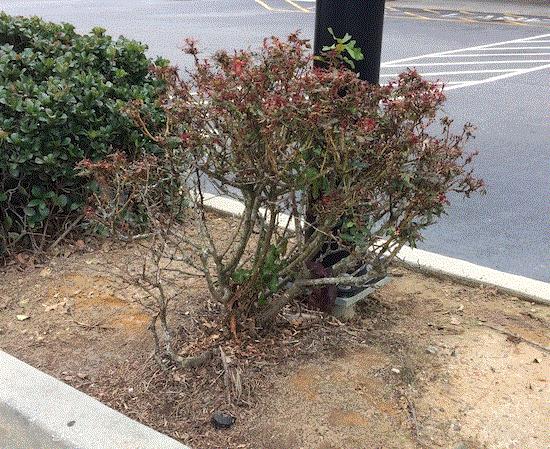
This Knock-Out rose bush in the parking lot of my local grocery store first showed symptoms of rose rosette disease three years ago.
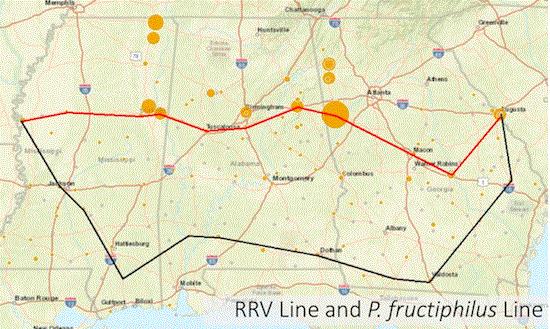
Rose rosette disease is present north of the red line, whereas its eriophyid mite vector (Phyllocoptes fructiphilus) is present up to the black line. (Photo credit: Katherine Solo, University of Tennessee)
Sure enough, Katherine’s work found a border for the rose rosette disease and one for the mite, Phyllocoptes fructiphilus. The disease border runs roughly from Greenville, Mississippi, through Tuscaloosa, Alabama, to Macon and Augusta, Georgia. The disease is not detected north of this line. The mites, on the other hand, are distributed further south. Interestingly, Katherine also detected, in addition to P. fructiphilus, several previously unknown eriophyid mite species associated with symptomatic and asymptomatic roses. The identification of these species is ongoing, and their relationships with rose rosette disease are not entirely clear at this time.
This research raises the question of why rose rosette disease and the eriophyid mites are distributed the way they are. It will take more research to answer this question.
Someone in the audience asked if he would also see such a border in North Carolina. And I thought, “Yeah, what about South Carolina?” When I got back in the office, I sent an email to my friends, Meg Williamson and Diana Low at Clemson University’s Plant and Pest Diagnostic Clinic (PPDC). I asked Meg and Diana to search the PPDC database for diagnostic records, and plotted the records (and my own observations) on a map.
I’ll be darned. I think I can draw a line through South Carolina. I can extend Katherine’s line from Augusta, through Aiken and Orangeburg, to Florence, South Carolina. The only thing I’m not certain of is whether the line will take a northerly trend from Florence, or straight east from Orangeburg. The only way I can figure that out is to do a survey of my own between Wilmington, North Carolina, and Charleston, South Carolina. Field trip!
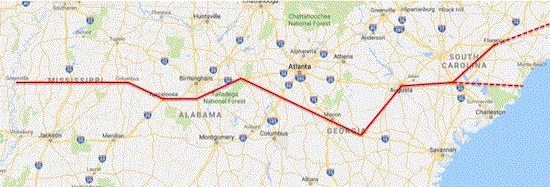
I think I can extend the rose rosette disease border from Augusta, Georgia, to Florence, South Carolina. The line may take a northerly route from Florence to North Carolina, or from Orangeburg east to Georgetown, South Carolina (dash lines).
Exciting find, isn't it?!
I would hate to tell the audience member, but if this line also hold true in South Carolina, then the entire state of North Carolina is likely suitable for the rose rosette disease.
For more information, go to the SCRI-supported Combating Rose Rosette project.

The 2019-2020 New England Greenhouse Floriculture Guide
Shout out to friends I met at the Tri-State Greenhouse IPM Workshop!
Margaret Skinner of the University of Vermont (UVM) invited me to participate in the traveling workshop a couple of weeks ago. I was chauffeured around Maine, New Hampshire and Vermont, and got to travel with Cheryl Frank Sullivan of UVM, Cheryl Smith and Anna Wallingford of the University of New Hampshire, and Alicyn Smart and Matt Wallhead of the University of Maine. Close to 150 people attended the workshop at the three locations. Can you believe it? This is the twenty-third year the group has been doing this traveling workshop.
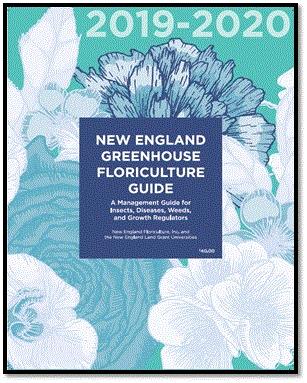
I was introduced to a great new pest management guide put together by faculty at six land-grant universities in New England, and published by New England Floriculture, Inc. The 2019-2020 edition of the New England Greenhouse Floriculture Guide includes detailed information, pest management tips and lists of pest management products for insects, mites, diseases, weeds and plant growth regulators. The 250-plus page guide also includes extensive sections on biological control and pollinator protection.
You can order a copy here. The cost is $40 per copy, shipping included ($50 per copy if shipping to Canada).
During my last two days in Burlington, Vermont, the city received more snow within a 24-hour period than Florence, South Carolina, would have received in four years. In Vermont, life went on and planes took off despite the snow. That large blanket of snow would have paralyzed Florence for a week, closed schools for two weeks and caused pile-ups at every intersection. Building a snowman or having a snowball fight, even ice fishing was just a little too much for my thin tropical blood. Although winter sports are not my cup of tea, I did enjoy the workshop very much!
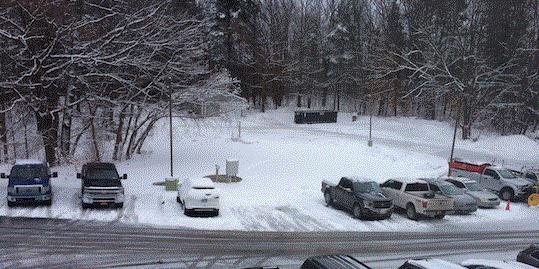
You want me to play out there? Um ... NO!
By the time y’all read this newsletter, I will be visiting a tropical fruit farm in Puerto Rico to help with its mealybug infestation. A high in the low 80s is forecasted for the week. So, which shorts should I wear?






See y'all next time!

JC Chong
Associate Professor of Entomology at Clemson University
This e-mail received by 24,823 subscribers like you!
If you're interested in advertising on PestTalks contact Kim Brown ASAP!